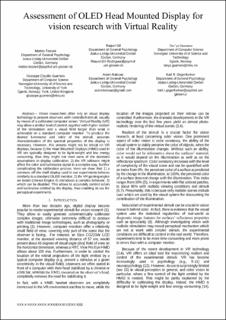| dc.contributor.author | Toscani, Matteo | |
| dc.contributor.author | Gil, Raquel | |
| dc.contributor.author | Guarnera, Dar'ya | |
| dc.contributor.author | Guarnera, Giuseppe Claudio | |
| dc.contributor.author | Kalouaz, Assim | |
| dc.contributor.author | Gegenfurtner, Karl | |
| dc.date.accessioned | 2020-09-02T08:33:42Z | |
| dc.date.available | 2020-09-02T08:33:42Z | |
| dc.date.created | 2020-09-01T17:34:41Z | |
| dc.date.issued | 2019 | |
| dc.identifier.isbn | 978-1-7281-5686-6 | |
| dc.identifier.uri | https://hdl.handle.net/11250/2675949 | |
| dc.description.abstract | Vision researchers often rely on visual display technology to present observers with controlled stimuli, usually by means of a calibrated computer screen. Virtual Reality (VR) may allow a similar level of control, together with higher realism of the stimulation and a visual field larger than what is achievable on a standard computer monitor. To produce the desired luminance and color of the stimuli, accurate characterization of the spectral properties of the display is necessary. However, this process might not be trivial on VR displays, because 1) the Head Mounted Displays (HMD) used in VR are typically designed to be light-weight and low energy consuming, thus they might not meet some of the standard assumptions in display calibration, 2) the VR software might affect the color and luminance signal in a complex way, further complicating the calibration process. Here we show that 1) a common, off-the-shelf display used in our experiments behaves similarly to a standard OLED monitor, 2) the VR gaming engine we tested (Unreal Engine 4) introduces a complex behavior, 3) which can be disabled. This allows to accurately control colors and luminance emitted by the display, thus enabling its use for perceptual experiments. | en_US |
| dc.language.iso | eng | en_US |
| dc.publisher | Institute of Electrical and Electronics Engineers (IEEE) | en_US |
| dc.relation.ispartof | 2019 15th International Conference on Signal-Image Technology & Internet-Based Systems (SITIS 2019) | |
| dc.title | Assessment of OLED Head Mounted Display for Vision Research with Virtual Reality | en_US |
| dc.type | Chapter | en_US |
| dc.description.version | acceptedVersion | en_US |
| dc.source.pagenumber | 738-745 | en_US |
| dc.identifier.doi | 10.1109/SITIS.2019.00120 | |
| dc.identifier.cristin | 1826586 | |
| dc.relation.project | Norges forskningsråd: 288670 | en_US |
| dc.description.localcode | © 2020 IEEE. Personal use of this material is permitted. Permission from IEEE must be obtained for all other uses, in any current or future media, including reprinting/republishing this material for advertising or promotional purposes, creating new collective works, for resale or redistribution to servers or lists, or reuse of any copyrighted component of this work in other works. | en_US |
| cristin.ispublished | true | |
| cristin.fulltext | postprint | |
| cristin.qualitycode | 1 | |
